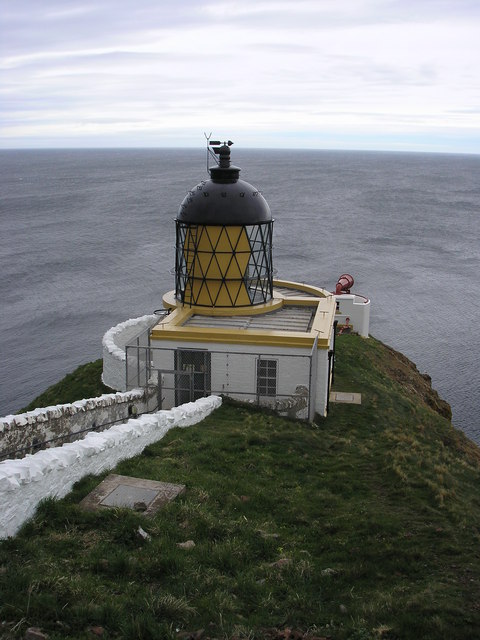St Abbs Head Lighthouse
nr Eyemouth, Berwickshire
|

Location Guide |
This lighthouse is situated at the very tip of a rocky headland,
known as St Abbs Head, north of Eyemouth.

 Photo by Iain
Lees
Photo by Iain
Lees

A signal station was first established on the
cliffs before 1820. The lighthouse designed and built by David and Thomas
Stevenson, became operational here in 1862, after a number of disasters.
Originally the light was oil powered and was converted to electric operation in
1966. The light is at 255 feet and is reached by a flight of steps leading down
the cliff from the lightkeepers' house above. The lighthouse was staffed by
three full time keepers whose duties included keeping detailed weather records.
Once it was automated in 1993 then the light keepers left.
A foghorn was established at the head in 1876
and was the first audible fog signal in Scotland. It was discontinued in 1987.
The land around the lighthouse is a National
Nature Reserve and is managed by the
National Trust for
Scotland, who have a visitor centre with an exhibition about the head, a coffee shop, art
gallery and textile shop. It was classed as a National Nature Reserve because of
it's 60,000 seabird colony, which nests on ledges on the sheer cliffs, with
Kittiwakes and Guillemots the largest colonies to nest (April-August), but also
there are Razorbills, Shags, Herring Gulls, Fulmars and Puffins. But also
because of its rich habitat of flora such as Wild Thyme and Rock Rose, which
around 10 different kinds of butterflies like to feed on.
who have a visitor centre with an exhibition about the head, a coffee shop, art
gallery and textile shop. It was classed as a National Nature Reserve because of
it's 60,000 seabird colony, which nests on ledges on the sheer cliffs, with
Kittiwakes and Guillemots the largest colonies to nest (April-August), but also
there are Razorbills, Shags, Herring Gulls, Fulmars and Puffins. But also
because of its rich habitat of flora such as Wild Thyme and Rock Rose, which
around 10 different kinds of butterflies like to feed on.
The lighthouse has 2km of single track road
leading to it from the main road near St. Abbs village, however it is suggested
by the National Trust of Scotland that it is only used by disabled visitors as
there is limited parking. Visitors can walk to the Head where the lighthouse's
buildings, though still in good repair, are not open to the public.
|
Lighthouse information Grid
|

|
Please let us know any other information that we
can add to the Grid or page and any errors that you discover. Before making a long trip to any location it is always
wise to double check the current information, websites like magazines may be
correct at the time the information is written, but things change and it is of
course impossible to double check all entries on a regular basis. If you have
any good photographs that you feel would improve the illustration of this page
then please let us have copies. In referring to this page it is helpful if you
quote both the Page Ref and Topic or Section references from the Grid below. To print the
planning grid select it then right click and print the selected area.
Please submit information on locations you discover so
that this system continues to grow.
|